What to Build for First: Apple or Android
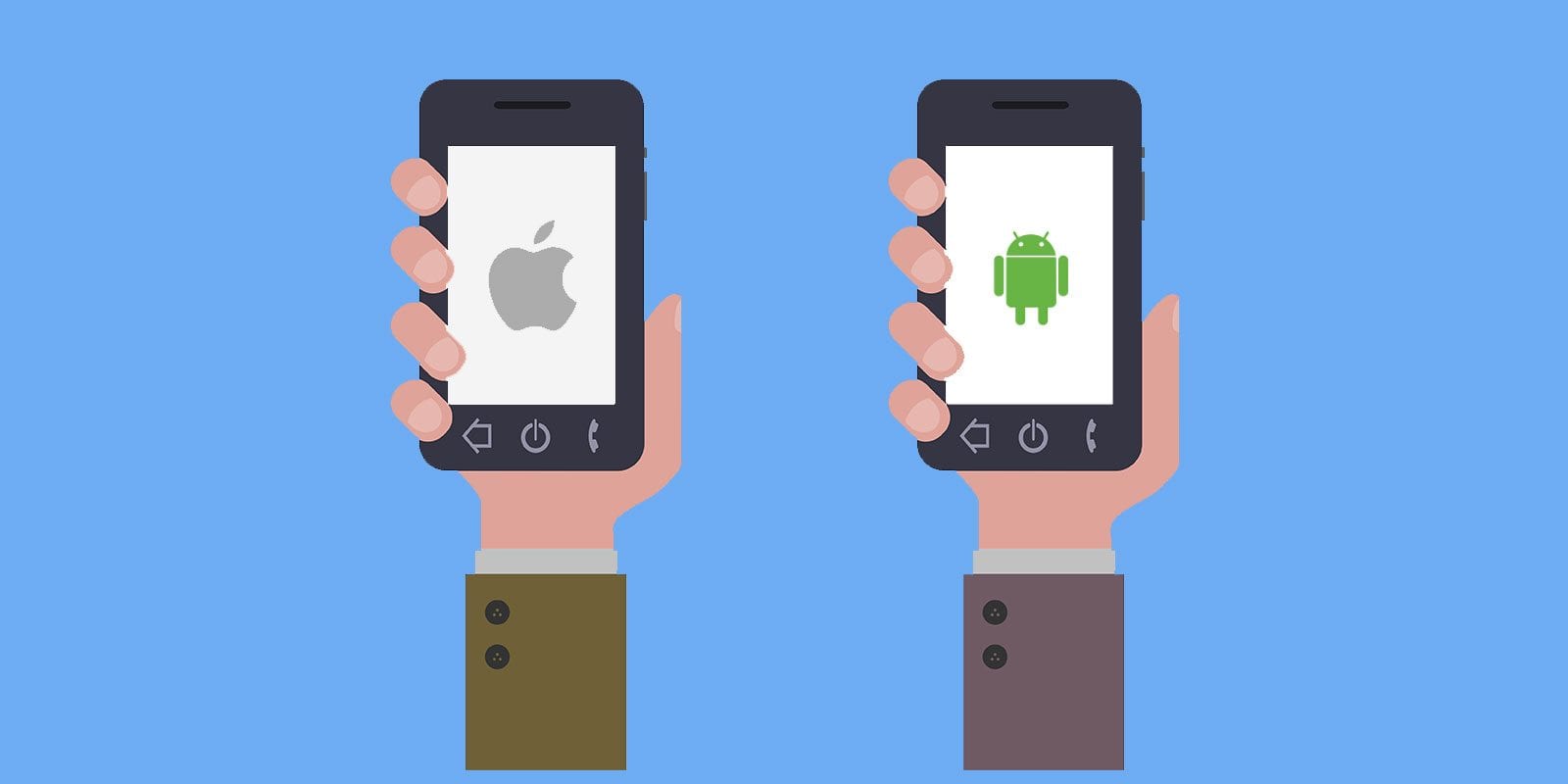
So you’ve got a basic idea for a mobile app that you want to build.
The purpose of this app could be to improve your existing business, or maybe you’re building it to launch a startup company.
Regardless of your reason, you’ve got lots of decisions to make and a long road ahead of you in terms of the development process.
Don’t be intimidated.
This is an exciting time for you and your company.
Before you can start building, you’ll need to determine if you want your app launched on the Google Play Store or Apple App Store.
There are significant advantages and disadvantages for developing on either of the two most popular mobile operating systems.
Can you build on both?
In short, yes. But we’ll get into that a bit later on.
That option could be pricey. So if you can only afford to build one right now, I’ll help you decide which is best for your app.
It’s a critical decision because Apple and Android users behave differently.
So if your primary target market uses one platform and you develop for the other, then it would be a terrible mistake.
But there’s much more to it than just the user.
I’ll break down all of the factors that you need to consider before you finalize a decision.
Here they are.
Feature sets
The features are related to the basic functions of your app.
What exactly is the purpose of your app?
The answer to this question will depend on the code that gets written for development.
Apple
Apple is restricted to a closed ecosystem.
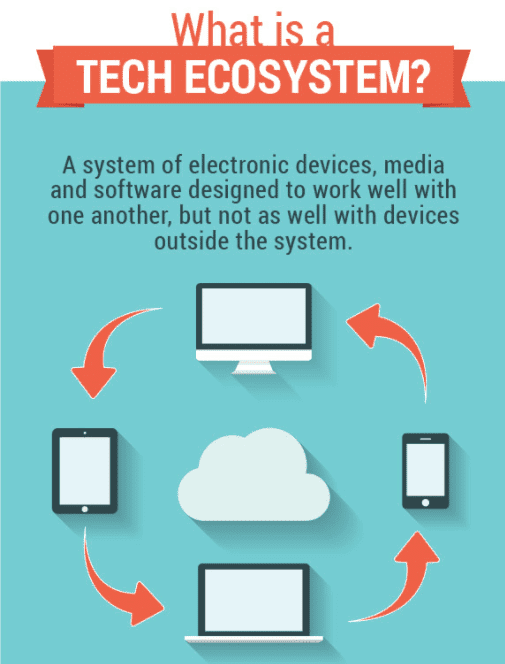

A closed ecosystem means that Apple regulates entrance to use their platform.
All of the content is restricted to specific devices that are supported by that ecosystem.
This means that as a developer you’ll have to use Apple’s features, but there are a lot of them.
The advantage to developing your app on a closed ecosystem like Apple’s means that there’s more control and stability.
But with that said, there will be more restrictions for the developer.
From the user perspective, purchasing a device that operates on a closed ecosystem means that it will have a higher price point.
So in general, Apple devices are more expensive than Android devices.
This gives you some more insight about the user, but we’ll get into that in greater detail shortly.
Android
Android operates on an open source ecosystem.

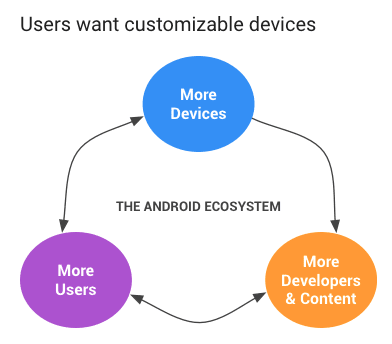
This allows for tons of modifications as well as lots of functionality.
Open source platforms are less secure.
So sometimes updates get blocked by mobile network operators.
Android has an open platform to encourage developer innovation.
You can get Android’s source code for free and port it to your app’s hardware.
This means you won’t have to jump through as many hoops to develop your app on the Android system because there are less restrictions.
How to make money
The purpose of every mobile application is to make money, right?
If that’s not your primary goal, you’ll probably need to reevaluate your decision to build an app in the first place.
So how do you plan to make money?
Here are a few of the most common business models.
- Subscriptions
- In-app purchases
- Advertisements
- Pay per download
Depending on which strategy (or strategies) you decide to implement can impact your decision for developing on Apple or Android.
Apple
If you’re going to charge users to download your app, you should develop on Apple first.
Take a look at the distribution of free vs. paid apps between Apple and Android.

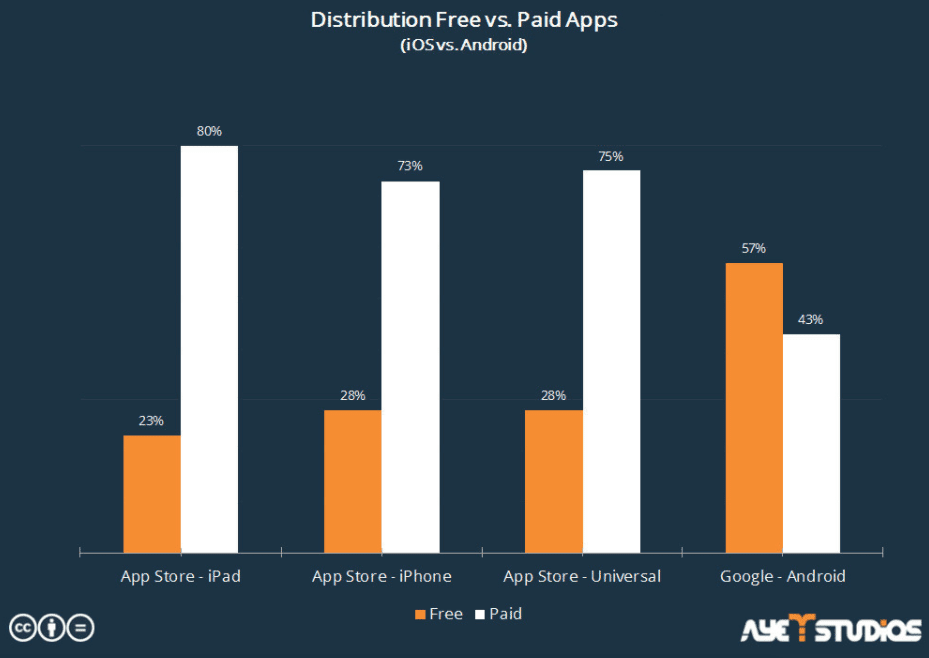
As you can see from the graph, there is a clear difference between the two platforms.
So if you’re going to charge for downloads, the Apple App Store is the place to do it.
That’s because those users are used to seeing more paid apps and less free apps when they’re searching for something to download.
Whereas Android users don’t see as many apps that require payment to download.
So if they see yours, they’ll probably consider just finding another one that has similar functions and is offered for free.
Just know that if you’re going to charge Apple users to download your app, it’s going to be an expensive strategy.
You’ll have a much higher customer acquisition cost than if you offered it for free.
But with that in mind, you’ll also make more money all at once.
Your users will be more engaged as well.
If they’re willing to pay for it, that means they probably won’t abandon it.
Android
If you’re going to make money off of advertisements and in-app purchases, then you should build on Android first.
Just don’t expect your in-app purchases to be too significant.


You’re going to get less money per purchase, but that’s spread over way more people.
Android users dominate the market share.
I’ll show you some more specific numbers when we talk about the different types of people using your app in a little bit.
The advantage of releasing your app for free on the Android platform is that you’ll be able to get more downloads.
But your users may not be as engaged since they’re not investing anything into the download.
So the key to this strategy is coming up with a way to get money from people who use the app the most.
Charge for app upgrades and premium services to enhance their experience.
Release cycles
Here’s something that developers don’t always think about right away when they’re trying to figure out which platform is better for their business.
You’ve got to consider which software version your users are using within their respective platforms.
Obviously, your app needs to be written in code that’s compatible for with the most up to date software versions.
But there’s a major difference between Apple and Android devices here.
Apple
The majority of Apple users are running their device on the most current version.
In fact, 95% of Apple users have one of the two latest operating systems installed on their devices.
This makes programming and development easier because you can estimate what your app is going to be able to do.
You’ll just need to be prepared to come up with more updates to optimize the user experience based on the software they’re using.
But for the most part, you won’t need to worry about software from a few years ago.
Android
Android users are not all up to date on the most current operating platform.

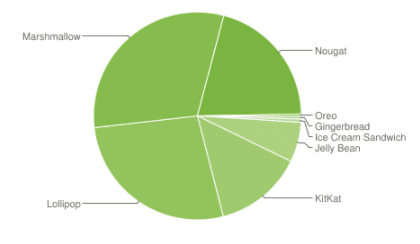
Since these users are all over the place, you might have to develop for older versions that are out of date.
Oreo and Nougat are the two most recent versions of the Android software.
Less than 20% of users are operating on these systems.
This makes your development process more complicated since you have to accommodate such a wide range of versions.
Who uses the devices
Now it’s time for you to consider who is going to be using your app.
If you have an existing business and you’re planning to use this app as another source of income, turn to your current customers as a reference.
What devices are they using?
For those of you that are developing an app for a startup company, you’ll need to consider your target market.
Some basic aspects to consider are:
- Age
- Location
- Income
You’ll obviously need to come up with a customer profile that’s much more in-depth than this to help you with your marketing strategy, but for now this is a great place to start.
Apple
While the ratio of Android to Apple users in the United States is closer to 50/50, that’s not the case for the rest of the world.

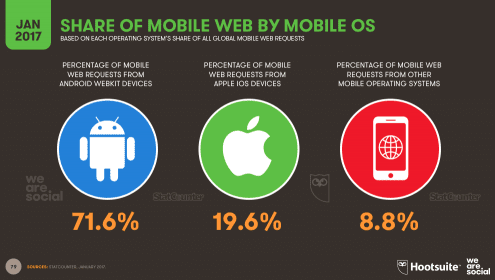
So if you have an international target market, I’d stay away from developing on Apple’s platform first.
Apple users make more money than people who have an Android device.
In fact, the median annual salary for iPhone users is about $85,000.
Younger generations are also more likely to have an Apple device than an Android device.
Take all of this into consideration if you’re planning to launch your app on the iOS system first.
Make sure it fits the criteria for your target market.
Android
While Apple users fit more into a niche category, Android users represent everyone else.
Take a look at some of the key differences between these two groups of people.

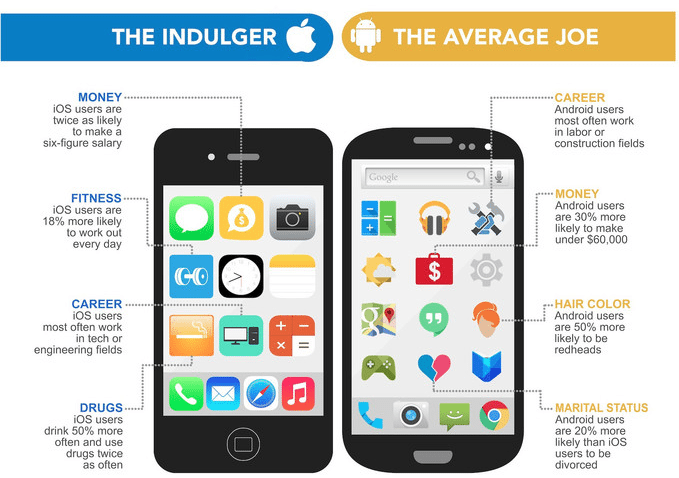
If your target market represents people from all over the world who are blue collar workers, your best bet is to develop on Android over Apple.
That’s why earlier we discussed that Android users are less likely to pay for an app or make an in-app purchase.
It’s because they just don’t make as much money as iPhone users, so they are more sensitive to price.
Keep this in mind if you have an ecommerce store and you’re developing an app as another way for your existing customers to make purchases.
Tablet usages
When people think about building mobile applications, they immediately think of cell phones.
But you’ve got to take tablets into consideration as well.
Look at how tablet ownership has been trending.


Over a stretch of five years in the United States, we saw a 42% increase in tablets owned.
That number is continuing to rise.
So you need to keep tablets in mind when you’re developing your app.
Apple
Most people like to use iPads because they are user friendly.
These tablets are sleek and easy to use.
They are a popular choice for young children as well as older generations.
The users who use Apple tablets will watch movies, play games, or spend time doing other fun activities.
Android
On the other hand, people who own Android tablets are more technical.
They may be using these devices to work on a project or own one because they use it for their job.
Overall, Apple tablets seem to dominate Android.
You may even see some people who have an Android phone but use an iPad tablet.
But iPhone users are much more loyal to Apple’s tablets and other devices.

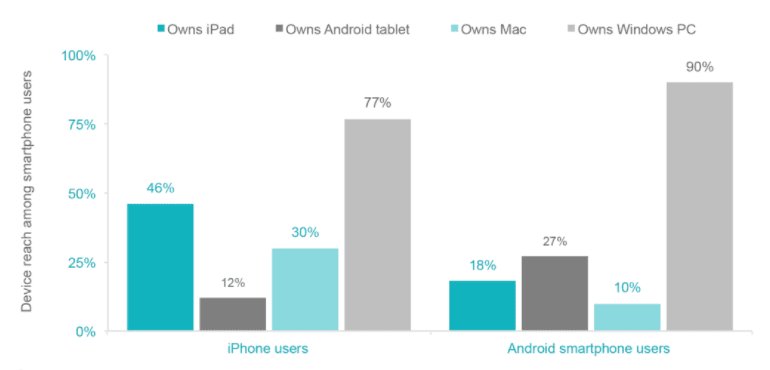
You’re way less likely to see an iPhone user with an Android tablet than an Android smartphone user with an iPad.
Enterprise adoption
Remember when Blackberry used to dominate the workplace market?
It seemed like everyone wearing a suit and holding a briefcase had a Blackberry in their hand as well.
But those days are over.
Apple
Apple devices are known to be more secure.
We discussed this earlier when we talked about their closed ecosystem.
That’s why you’ll see major corporations like IBM partnering with Apple for their corporate devices.
But with increased security comes fewer features.
Android
Since Android is open source, it’s less secure.
But with that said, there are way more devices and even more features.
Apple users have to get an iPhone or iPad to access your mobile app.
While there may be different versions of those devices, you can’t compare that to the number of devices that operate on the Android platform.
That’s probably another reason why Android dominates the global market share.
Why Apple first
So when should you build your app for Apple first?
To sum it, it’s better to go with Apple when you’re first starting out.
Developing for Apple is quicker and less expensive.
Building your app for Android will cost you about 30% more money.
Although you’ll have some more restrictions and regulations with Apple because it’s a closed ecosystem, it’s still the best way to make money quick if you’re targeting the right demographic.
An example of this demographic would be users in the United States who make a high annual salary.
If you’re planning to charge users to download your app, you should release it on Apple first.
Why Android first
You should develop on Android first if you need your app to access specific phone features that are not allowed on the iOS platform.
You’ll have much less restrictions and room for innovation on the Android open source ecosystem.
Android development is best for companies who don’t care about appealing to rich people or niche demographics.
It’s the best system to build for if you’re planning to have users from all over the world downloading your app.
When your app gets launched on the Google Play Store, it should be listed for free.
The majority of apps on this platform are free, so charging for downloads shouldn’t be your primary monetization strategy.
Instead, you can make money from in-app purchases and advertisements.
While each purchase may not be as significant as Apple purchases, you’ll be able to make a little bit of money from a larger number of people, which a profitable strategy.
Can you build for both platforms?
Yes.
But it’s not going to be cheap.
If you’ve got unlimited funds to hire two separate development teams, then you can accomplish this.
That’s not reasonable for most people.
You could also build a hybrid app to launch on both platforms simultaneously.
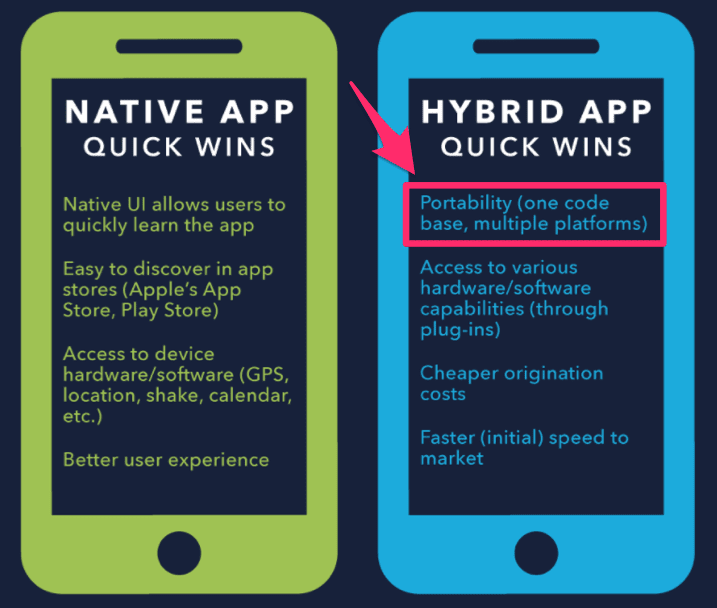

Hybrid apps are a possibility if your app has a basic level of functionality that can be achieved on MADP.
If you need to change platforms make sure you’ve got a good reason.
Spend time to conduct the proper research ahead of time to avoid this. Otherwise, it could be a costly decision.
Conclusion
So, what’s the best app to build for first?
As you can see from everything we’ve discussed, there’s not a right or wrong answer.
Everyone’s situation is unique.
There are specific circumstances where developing for Apple makes the most sense and other scenarios where you should build for Android.
Ultimately, the decision is yours.
It’s not something that you should rush into.
As you probably know by now, app development is expensive.
You don’t want to start building an app on the wrong platform, or you won’t be able to make as much money and get a return on your investment.
Refer to the different elements that I’ve discussed in this post to give you some guidance.
Hopefully, this has given you enough insight to make the right decision for your unique situation.
Are you planning to build your mobile app on the Apple or Android platform first?